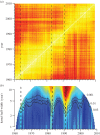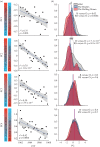The evolution of popular music: USA 1960-2010
- PMID: 26064663
- PMCID: PMC4453253
- DOI: 10.1098/rsos.150081
The evolution of popular music: USA 1960-2010
Abstract
In modern societies, cultural change seems ceaseless. The flux of fashion is especially obvious for popular music. While much has been written about the origin and evolution of pop, most claims about its history are anecdotal rather than scientific in nature. To rectify this, we investigate the US Billboard Hot 100 between 1960 and 2010. Using music information retrieval and text-mining tools, we analyse the musical properties of approximately 17 000 recordings that appeared in the charts and demonstrate quantitative trends in their harmonic and timbral properties. We then use these properties to produce an audio-based classification of musical styles and study the evolution of musical diversity and disparity, testing, and rejecting, several classical theories of cultural change. Finally, we investigate whether pop musical evolution has been gradual or punctuated. We show that, although pop music has evolved continuously, it did so with particular rapidity during three stylistic 'revolutions' around 1964, 1983 and 1991. We conclude by discussing how our study points the way to a quantitative science of cultural change.
Keywords: cultural evolution; diversity; popular music; stylistic revolutions.
Figures






References
-
- Adorno TW. 1941. On popular music. Stud. Philos. Soc. Sci. 9, 17–48.
-
- Adorno TW. 1975. Culture industry reconsidered. New German Critique 6, 12–19. (doi:10.2307/487650) - DOI
-
- Frith S. 1988. Music for pleasure. Cambridge, UK: Polity Press.
-
- Mauch M. 2011. The anatomy of the UK charts: a light-hearted investigation of 50 years of UK charts using audio data; collection of 5 blog posts. See http://schall-und-mauch.de/anatomy-of-the-charts/.
-
- Negus K. 1996. Popular music theory. Cambridge, UK: Polity.
LinkOut - more resources
Full Text Sources
Other Literature Sources

